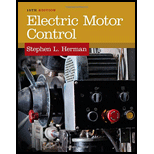
Electric Motor Control
10th Edition
ISBN: 9781133702818
Author: Herman
Publisher: CENGAGE L
expand_more
expand_more
format_list_bulleted
Concept explainers
Question
Chapter 33, Problem 3SQ
To determine
Explain the necessity of definite time intervals between each speed change on deceleration.
Expert Solution & Answer
Want to see the full answer?
Check out a sample textbook solution
Students have asked these similar questions
a diode current is 0.6 ma when applied voltage is 400 mv and 20 ma when applied voltage is 500 mv.find n.assume vt=26mv
4. Impedance of each leg of the load is 2+j2 ohms. Find the 3-phase power consumed by the loads.
I need help with this problem and an explanation of the solution for the image described below. (Introduction to Signals and Systems)
Chapter 33 Solutions
Electric Motor Control
Ch. 33 - Prob. 1SQCh. 33 - Prob. 2SQCh. 33 - Prob. 3SQCh. 33 - What is the primary reason for using a compelling...Ch. 33 - What is the purpose of an accelerating relay?Ch. 33 - When is it most important to use decelerating...Ch. 33 - Why are different motor connections shown for what...Ch. 33 - How many windings are required for three-speed...
Knowledge Booster
Learn more about
Need a deep-dive on the concept behind this application? Look no further. Learn more about this topic, electrical-engineering and related others by exploring similar questions and additional content below.Similar questions
- Using C-H Theorem to find A2, A3 for A=( 6 6arrow_forward- Apply the Gauss-Jordan method to the following system: X1 X2 X3+ x4 = 1 X1+2x2+2x3 + 2x4 = 0 X1+2x2+3x3 + 3x4 = 0 X1+2x2+3x3 + 4x4 = 0arrow_forwardSolve the following circuit using Gauss Elimination method, V/R=1; R R R R 1 R 12 13 V Varrow_forward
- NEED HANDWRITTEN SOLUTION DO NOT USE AIarrow_forwardI need help with this problem and an explanation of the solution for the image described below. (Introduction to Signals and Systems)arrow_forwardI need help with this problem and an explanation of the solution for the image described below. (Introduction to Signals and Systems)arrow_forward
arrow_back_ios
SEE MORE QUESTIONS
arrow_forward_ios
Recommended textbooks for you

 Electricity for Refrigeration, Heating, and Air C...Mechanical EngineeringISBN:9781337399128Author:Russell E. SmithPublisher:Cengage Learning
Electricity for Refrigeration, Heating, and Air C...Mechanical EngineeringISBN:9781337399128Author:Russell E. SmithPublisher:Cengage Learning


Electricity for Refrigeration, Heating, and Air C...
Mechanical Engineering
ISBN:9781337399128
Author:Russell E. Smith
Publisher:Cengage Learning